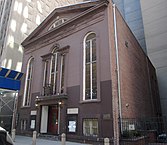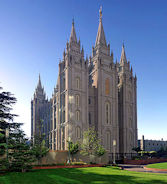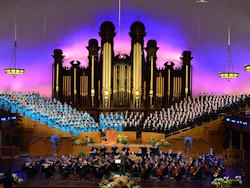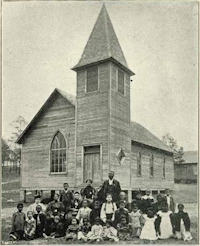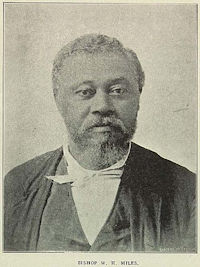This section presents influential churches in the foundations for and/or the development of gospel music.
____________________________________________________________________________
The African Methodist Episcopal (A.M.E.) Church
The African Methodist Episcopal Church, usually called the A.M.E. Church or AME, is a predominantly African-American Methodist denomination based in the United States. It is the first independent Protestant denomination to be founded by black people. It was founded by the Rt. Rev. Richard Allen in Philadelphia, Pennsylvania, in 1816 from several black Methodist congregations in the mid-Atlantic area that wanted independence from white Methodists. It was among the first denominations in the United States to be founded on racial rather than theological distinctions and has persistently advocated for the civil and human rights of African Americans through social improvement, religious autonomy, and political engagement. Allen, a deacon in Methodist Episcopal Church, was consecrated its first bishop in 1816 by a conference of five churches from Philadelphia to Baltimore. The denomination then expanded west and south, particularly after the Civil War. By 1906, the AME had a membership of about 500,000, more than the combined total of the Colored Methodist Episcopal Church in America and the African Methodist Episcopal Zion Church, making it the largest major African-American Methodist denomination in the nation. The AME currently has 20 districts, each with its own bishop: 13 are based in the United States, mostly in the South, while seven are based in Africa. The global membership of the AME is around 2.5 million and it remains one of the largest Methodist denominations in the world.
Source: Wikipedia
‘On 19th-century African American Music’
“Outside of the church, the creative musical expression of the African American population was flourishing. African Americans began arriving in Chicago as early as 1840, and over the next 75 years, they established orchestras and created instrument clubs that trained their children in piano and string instruments. Much of this talent was first cultivated in the church. On Sundays, musicians and singers were directors, pianists, organists, and members of church choirs at established Chicago African American congregations like Olivet Baptist Church or Bethel African Methodist Episcopal (AME) Church. During the week, they performed in the Chicago Loop, on concert stages, and in musical extravaganzas and pageants.
Over the years, these mainline black churches that served as the church homes for these professional singers, composers, and musicians had developed a robust musical infrastructure. The senior choir led the congregation in hymns included in Gospel Pearls, 1921, the first African American publication of songs for worship services, and concertized spirituals (also known as “Jubilee Songs”) to a pipe organ background.
Some songs even dated back to the beginning of the 19th century. Bishop Richard Allen, the founder of the AME church, published a book of hymns expressly for African Americans. Allen saw a need for a separate established body of sacred songs in worship that spoke to the existence and survival of people of African ancestry in America to document and preserve their religious heritage.
At the end of the century, AME pastor and theologian Charles Tindley wrote a number of hymns, many of which complemented the sermons he delivered to his congregation. Later known as the “Father of African American Hymnody,” Tindley gained a reputation for his generosity and freely shared his music with other musicians and composers. One of his best-known songs, “I’ll Overcome,” later was the basis for “We Shall Overcome,” an anthem of the civil rights movement, and his lyrics often spoke of deliverance through change and suffering. But despite Allen and Tindley’s contributions, the performance and style of Northern black churches continued to be influenced by Anglo norms. It would take two historical events to change that”.
Source: Christianity Today
LInks for further reference and more in-depth research:
____________________________________________________________________________
The African Methodist Episcopal Zion (A.M.E.Z.) Church
The African Methodist Episcopal Zion Church, or the AME Zion Church or AMEZ, is a historically African-American denomination based in the United States. It was officially formed in 1821 in New York City, but operated for a number of years before then.
(The AME Zion Church is not to be confused with the similarly named African Methodist Episcopal Church, which was officially formed in 1816 by Richard Allen and Daniel Coker in Philadelphia. The denomination was made up of AME churches in the Philadelphia region, including Delaware and New Jersey.)
The AME Zion church can be traced back to the John Street Methodist Church of New York City. Following acts of overt discrimination (such as black parishioners being forced to leave worship), many black Christians left to form their own churches. The first church founded by the AME Zion Church was built in 1800 and was named Zion; one of the founders was William Hamilton, a prominent orator and abolitionist. These early black churches were still part of the Methodist Episcopal Church denomination, although the congregations were independent.
The fledgling church grew and soon multiple churches developed from the original congregation. These churches were attended by black congregants, but ministered to by white ordained Methodist ministers. In 1820, six of the churches met to ordain James Varick as an elder, and in 1821 he was made the first General Superintendent of the AME Zion Church. A debate raged in the white-dominated Methodist church over the possibility of black ministers. This debate concluded on July 30, 1822, when James Varick was ordained the first bishop of the AME Zion church. The total membership in 1866 was about 42,000. Two years later it claimed 164,000 members. The A.M.E. Zion Church was part of the Abolitionist Movement and became known as the Freedom Church.
Black churches played an increasingly powerful role in the civil rights movement. AMEZ remained smaller than AME because some of its ministers lacked the authority to perform marriages, and many of its ministers avoided political roles. Its finances were weak, and in general its leadership was not as strong as AME. However it was the leader among all Protestant denominations in ordaining women and giving them powerful roles. One influential leader bishop was James Walker Hood (1831-1918) of North Carolina. He not only created and fostered his network of AMEZ churches in North Carolina, but he also was the grand master for the entire South of the Prince Hall Masonic Lodge, a secular organization that strengthen the political and economic forces inside the black community.
Source: Wikipedia (image ref: By Beyond My Ken – Own work, CC BY-SA 4.0, https://commons.wikimedia.org/w/index.php?curid=26980846)
“Traditions such as the kiss of peace and the charismatic praise songs are all but nonexistent in Zion Methodism. There is, in the orthodox mind of Zion, a resistance to clapping (which is deemed applause) in worship. This resistance is fading with the demand for upbeat modern gospel music from both clergy and laity alike. This movement has accompanied the emergence of far more forms of expression in worship than have been historic to Zion Methodism.
Praise and Song. The reality of Zion, in spite of the orthodox hierarchy, is that its main area of strength has been expressive forms of praise. These include the continuation of the common meter form of singing and praise devotional services. The more animated style of the processional “strut” of gospel choirs and the emotional expression now being found throughout Zion are simply the rediscovery of its true worship roots.”
Source: Worship Training
Links for further reference and more in-depth research:
____________________________________________________________________________
The Church of God in Christ (COGIC)
History
Bishop Charles Harrison Mason was the founder and first senior bishop of the Church of God in Christ (COGIC), presently the largest African-American Pentecostal church in the United States.
Born to former slaves Jerry and Eliza Mason in Shelby County, Tenn., on Sept. 8, 1864, Mason worked with his family as a sharecropper and did not receive a formal education as a child. But at an early age, he was influenced by his parents’ religion.
Mason joined the African-American Missionary Baptist Church when he was an adolescent and later received his license to preach from the Mount Gale Missionary Baptist Church in Preston, Ark. In November 1893, Mason enrolled at the Arkansas Baptist College, but withdrew after three months to transfer to the Minister’s Institute at the College; he graduated from the Institute in 1895.
In 1895, Mason met Charles Price Jones, a popular Baptist preacher from Mississippi. Mason and Jones soon began preaching the doctrine of holiness and sanctification in the local Baptist churches, which led to their expulsion from the Baptist Convention.
Mason and Jones decided to form a new fellowship of churches. Mason suggested the name Church of God in Christ, after what he described as a vision in Little Rock, Ark., to distinguish the church from a number of “Church of God” groups forming at that time.
Due to disagreements in the new Pentecostal teachings, the two men split their group in 1907. Mason won the legal rights to the Church of God in Christ name and charter, and established his work in Memphis.
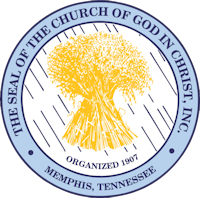 After moving the COGIC headquarters to Memphis, Mason established additional departments and auxiliaries, created dioceses, and appointed overseers throughout the country.
After moving the COGIC headquarters to Memphis, Mason established additional departments and auxiliaries, created dioceses, and appointed overseers throughout the country.
In 1945, Mason dedicated Mason Temple in Memphis as the church’s national meeting site and the international headquarters of the Church of God in Christ.
At the time of Mason’s death on Nov. 17, 1961, COGIC had a membership of more than 400,000 and more than 4,000 churches in United States as well as congregations in Europe, South America, Africa, and Asia.
Today, it has an estimated 6.5 million members. The church can be found in every state in the United States and in more than 87 countries around the world.
Source: COGIC website
COGIC Music Department
Pentecostals have been known and continue to be known for their lively worship, exuberant expressions of praise and worship, and musical compilations, mostly relying on congregational singing of hymns and chants. The COGIC emphasized the use of the choir as an integral part of the worship experience. From the very beginning of gospel music, COGIC members have influenced its rise. In the 1920s, Arizona Dranes, a blind Evangelist Missionary became one of the first gospel artists to bring the musical styles of COGIC to the public in her records for Okeh and performances. Later, Sister Rosetta Tharpe, Evangelist Goldia Haynes, Elder Utah Smith and Madame Earnestine Washington continued COGIC’s influence throughout the fifties and sixties. Mrs. Anna Broy Crockett Ford was the first organizer and Director of the National Music Department, which was formally established in November 1949.
COGIC became a staple of gospel music under the guidance and leadership of Dr. Mattie Moss Clark. (1968–1994). She revolutionized and reorganized the music ministry to become a leading department in the church. She developed the role of the State Minister of Music and traveled the world conducting seminars and workshops perfecting the quality of choir music, their performance, and the COGIC sound. Under her leadership and tenure, COGIC choirs and individual singers came to dominate gospel music producing a number of recordings and gospel hits. Her daughters formed the legendary “Clark Sisters” who helped introduce and became leaders of the contemporary gospel music era. In 1982 during the Seventy-Fifth Holy Convocation, the diamond jubilee of the church, COGIC published its own hymnal, Yes, Lord!, which included many arrangements and songs written by COGIC and African-American musicians and songwriters. She is the longest serving president of the International Music Department and her influence and legacy is recognized around the world.
Influence of COGIC on Gospel Music
Well-known gospel musicians with COGIC roots include; Andrae Crouch and Sandra Crouch, Walter Hawkins and Edwin Hawkins, Tramaine Hawkins, Sara Jordan Powell Daryl Coley, BeBe and CeCe Winans, The Winans, “Detroit” Gary Wiggins, John P. Kee, The O’Neal Twins, Vanessa Bell Armstrong, Rance Allen, Rev. Timothy Wright, Myrna Summers, Rev. James Moore, Thomas Whitfield (singer), Deniece Williams, Hubert Powell, Donnie McClurkin, LaShun Pace, The Anointed Pace Sisters, Bishop Richard “Mr. Clean” White, Bishop Paul S. Morton and The Clark Sisters (Jackie Clark-Chisholm, Elbernita “Twinkie” Clark-Terrell, Dorinda Clark-Cole and Karen Clark Sheard). COGIC continues to influence gospel music with a new generation of artists with COGIC roots that include: Kim Burrell, Ivan Powell, Doobie Powell, Kierra Sheard, J. Moss, Micah Stampley, Kurt Carr, Ricky Dillard, Kelly Price, Mary Mary Erica Campbell (musician) and Tina Campbell (musician), Tamela Mann, Dr. Gennie Ruth Cheatham Chandler, Earnest Pugh, Jonathan McReynolds, Jabari Johnson, DuShawn Washington, Trombonist Terrance Curry, D’Extra Wiley (II D Extreme) and Michelle Williams (Destiny’s Child). The current leader of the International Music Department is Dr. Judith Christie McAllister of Los Angeles, California, who is also a praise and worship national recording artist.[27] Professor Iris Stevenson-McCollough former International Music Department President(Originally from Rochester, NY) She is a major influence in the gospel music industry around the world. there is a school named after her in Austria.
Souce: Wikipedia
Links for further reference and more in-depth research:
____________________________________________________________________________
The Church of Jesus Christ of Latter-day Saints (Mormon Church)
The Church of Jesus Christ of Latter-day Saints, often informally known as the LDS Church or Mormon Church, is a nontrinitarian, Christian restorationist church that is considered by its members to be the restoration of the original church founded by Jesus Christ. The church is headquartered in Salt Lake City, Utah in the United States, and has established congregations and built temples worldwide. According to the church, it has over 67,000 missionaries[3] and a membership of over 16 million. In 2012, the National Council of Churches ranked the church as the fourth-largest Christian denomination in the United States, with over 6.5 million members reported by the church, as of January 2018. It is the largest denomination in the Latter Day Saint movement founded by Joseph Smith during the period of religious revival known as the Second Great Awakening.
Adherents, often referred to as “Latter-day Saints” or, less formally, “Mormons”, view faith in Jesus Christ and his atonement as fundamental principles of their religion. LDS theology includes the Christian doctrine of salvation only through Jesus Christ, though LDS doctrines regarding the nature of God and the potential of mankind differ significantly from mainstream Christianity. The church has an open canon which includes four scriptural texts: the Bible (both Old and New Testaments), the Book of Mormon, the Doctrine and Covenants, and the Pearl of Great Price. Other than the Bible, the majority of the LDS canon constitutes revelation received by Joseph Smith and recorded by his scribes which includes commentary and exegesis about the Bible, texts described as lost parts of the Bible, and other works believed to be written by ancient prophets.
Source: Wikipedia (image ref: By derivative work: Entheta (talk)Salt_Lake_Temple,_Utah_-_Sept_2004.jpg: Diliff – Salt_Lake_Temple,_Utah_-_Sept_2004.jpg, CC BY 2.5, https://commons.wikimedia.org/w/index.php?curid=4646229)
‘Value of Gospel Music’
“Mormons love good music. They especially love good religious music. One leader pointed out a reason why when he said that “sometimes. . . we get nearer to the Lord through music than perhaps through any other thing except prayer” (J. Reuben Clark, Jr., Conference Report, Oct. 1936, p. 111). Another leader agreed. He said that “there is something in the spirit of song. . . an influence. . . and inspirational power. . . that fires the soul in a way that it can’t otherwise be touched or fired (Charles W. Nibley, Conference Report, Oct. 1917, p.75). But Mormon prophet Spencer W. Kimball was more specific about how music has such great effect. He said that “some of the greatest sermons that have ever been preached were preached by the singing of a song.” Others have pointed out that hymns and other religious music can lift and elevate our thoughts and actions and help establish a feeling of worship and love toward God and others.
Since Old Testament days music has played a part in worship. The Psalms of David and other books encourage worshipers to praise God and express their gratitude to him in song. Mormons believe that God delights in “the song of the heart” and that singing it will bring them blessings (D&C 25:12).
The apostle Bruce R. McConkie tells us in Mormon Doctrine that “Good music is eternal.” He points to the angelic choirs that sing hymns of praise throughout scriptures. Job mentions “the morning stars sang together and all the sons of God shouted for joy.” Notable, of course, was the angelic choir that sang at Jesus’ birth in Bethlehem. He also says that “Music is given of God to further his purposes” (MD, p. 521). He cites that music helps soften people’s hearts to receive the gospel and to sanctify and cleanse their souls after they receive it.
McConkie cautions that the best music will contain truth and not mislead listeners. He believes that the “songs that build faith and testimony and that teach the message of the restoration” are great musical compositions. He especially likes Come, Come Ye Saints; Now Let Us Rejoice; We Thank Thee O God for a Prophet; and The Spirit of God, which are LDS hymns. However, he says that “many of the great Christian hymns of all churches bear true witness of Christ and teach sound doctrine” (p. 521). He also says that “many religious Christmas carols are edifying and ennobling.” Of course, it’s probably well known that Mormons greatly admire Handel’s The Messiah and sing it particularly around Christmas.
The Mormon Tabernacle Choir’s rendition of The Messiah is very popular even among non-Mormons. This 360-member choir, started in 1847 (Mormon Tabernacle Choir website), tours the world, singing for heads of state, religious congregations, and the general public, giving their testimony in song. They’ve performed at the inauguration of five U.S. Presidents, and President Ronald Reagan named the choir “America’s Choir.” Of their numerous recordings, five have achieved “gold record” and two, “platinum record” status. The Battle Hymn of the Republic with the Philadelphia Orchestra won a Grammy in 1959 and the Choir was awarded the National Medal of Arts (for artistic excellence) in 2003. (Mormon Tabernacle Choir website) Members are proud of their choir, and those who have great voices jump at the opportunity just to audition for it. To sing in the choir is considered a calling in the Church, and Mormons who are privileged to serve this way spend many hours each week practicing and performing.
Mormon singers such as Gladys Knight also record gospel music, praising God and expressing their testimony in song. Over the years, the Osmond Family, including Donny and Marie, have sung religious songs in their performances, too. Countless other Mormon performers are well-known among the Mormon community but may be less well known among non-members.”
Source: Mormon Wiki
Links for further reference and more in-depth research:
Tabernacle Choir at Temple Square
____________________________________________________________________________
The Colored Methodist Episcopal (C.M.E.) Church
(re-named The Christian Methodist Episcopal Church in 1954)
The Christian Methodist Episcopal (C.M.E.) Church is a historically black denomination within the broader context of Methodism. It is also occasionally considered to be a mainline denomination. The group was organized on December 16, 1870 in Jackson, Tennessee, when several black ministers, with the full support of their white sponsors in the former Methodist Episcopal Church, South, met to form an organization that would allow them to establish and maintain their own polity. They ordained their own bishops and ministers without their being officially endorsed or appointed by the white-dominated body. They called this fellowship the Colored Methodist Episcopal Church in America, which it remained until their successors adopted the current name in the 1950s.
Source: Wikipedia (image ref: History of the Colored Methodist Episcopal Church in America by C. H. Phillips)
“The CME Church came into being in the tumultuous aftermath of the civil war and throes of Reconstruction. Beginning in 1619, the enslavement of native Africans, captured in their homeland and transported to America under horrendous conditions known as the Middle Passage, became integral to the American way of life. By the 19th century chattel slavery, especially on the cotton, cane and tobacco plantations of the South, had become the “Peculiar Institution.” Despite the principles and precepts of Jesus Christ, however, the Christian churches of the South not only approved and advocated slavery, but even accepted it in their midst. Foremost among them was the Methodist Episcopal Church, South, which in 1844 had separated from the Methodist Church over the issue of slavery. When the Civil War began in 1860, it had more slave members than any other religious denomination. At the end of the war, amidst its devastation, almost 100,000 members remained in the M. E. Church, South. It was of these members that in 1866 the General Conference of that church asked, “What shall be done to promote the religious interests of our colored members?”
The answer was predicated on the expressed desires and requests of those “Colored” members. For example, Isaac Lane of Tennessee, and later Founder of Lane College, said, “At once we made it known that we preferred a separate organization of our own . . . established after our own ideas and notions.” Lucius Holsey of Georgia, and later Founder of Paine College, wrote, “After emancipation a movement was at once inaugurated to give the Negroes a separate and independent organization.” Aware of these desires, James E. Evans, chair of the committee considering the issue, said, “The General Conference believed that the colored people, now that they are free, would desire a separate church organization for themselves.” Accordingly, the General Conference authorized the bishops of the church to organize their “Colored” members into their own “separate ecclesiastical jurisdiction.” Between 1866 and 1870 the bishops carried out the dictates of the General Conference. In May 1870 they reported that all necessary and legal steps had been taken to organize a separate church the following winter. So it was that those 41 former slaves gathered in Jackson in 1870 were duly elected and properly authorized to organize their own separate and independent “Colored Methodist Episcopal Church“(changed to “Christian Methodist” in 1954) they elected William Henry Miles and Richard H. Vanderhorst, the first bishops.”
Source: CME Church History (image ref: By Isaac Lane – Autobiography of Bishop Isaac Lane, LL.D. (Nashville, Tenn.: Publishing House of the M.E. Church, South, 1916), Public Domain, https://commons.wikimedia.org/w/index.php?curid=21410463
Links for further reference and more in-depth research:
____________________________________________________________________________



